Despite remaining the hottest border in the World, the Demilitarized zone between South and North Korea now attracts hundreds of visitors every day. If you are considering experiencing it yourself, my complete guide on how to visit DMZ and JSA from Seoul will answer all your questions.
Visiting the Demilitarized zone (DMZ) between North and South Korea is a must-see for every visitor coming to Seoul. However, the hottest and the most guarded borderline in the World is still a place of a very tense conflict and getting there bears many limitations. To help you make your way through all of them, I have prepared my complete guide on How to visit DMZ and JSA from Seoul.
As strange as it might sound, you can actually visit the DMZ and JSA from the North Korean side too. Koryo Tours are organizing various themed tours to North Korea, which can provide you with a truly unusual experience. I did not have the chance to experience this myself, so it is not covered in this post. However, if you are fascinated by the idea of visiting the most closed country in the World, be sure to check them out.
Key takeaways
1. Plan ahead: Visiting the DMZ and JSA requires advance planning, as you will need to apply for a permit in order to enter these areas. Make sure to obtain your permit several weeks in advance so that there are no issues with accessing them when you arrive.
2. Be prepared: As both the DMZ and JSA are such sensitive locations, be aware of all rules regarding photography and video recording before visiting either area – check online or ask at your hotel for more information on what is allowed or prohibited within each location.
3. Dress appropriately: Wear something smart-casual but avoid wearing anything offensive (e.g., military clothing) as this could cause offence among locals who may also be visiting the sites during your trip due to its proximity from Seoul city centre – remember it’s important not only respect cultural norms but also show respect towards those affected by Korea’s past wars which have shaped modern Korean culture today!
4. Use public transportation: The best way of getting around while sightseeing in South Korea is via public transport; Travelling by train between Seoul & Dorasan station (nearbyDMZ), then taking a bus tour into Panmunjom/Joint Security Areais an easy option if time permits–it takes approximately 4 hours one way including travel time from departure pointin Seoul Station/KTX Dorasan Station respectively).
What actually is the difference between DMZ and JSA?
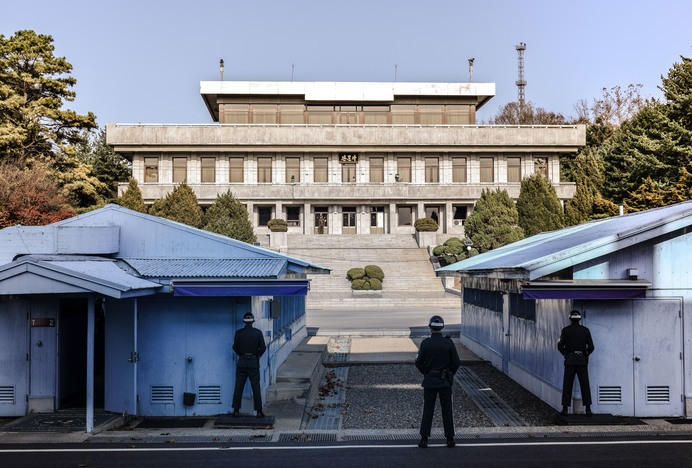
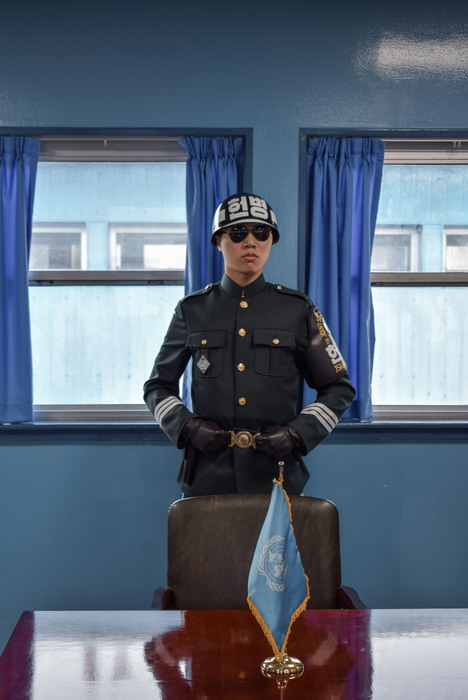
Basically, the only way how to visit DMZ and JSA from Seoul is with an organized tour, as such a visit requires a mandatory military escort. And there are several different tours available, depending on which parts of the DMZ you want to see. If you are like me, you will soon get lost in all the abbreviations and you want to know which of the parts are actually worth seeing. To help you out with that, I decided to bring you this overview.
First of all, let’s make clear what is the difference between the DMZ and the JSA and what do these two abbreviations actually represent.
Demilitarized zone (DMZ)
The DMZ is a buffer zone between the two Koreas, bisecting the Korean Peninsula more or less along the 38th parallel. The zone lies approximately 2 km north and south respectively from the ceasefire line of 1953. The land stretches across the Korean Peninsula almost 250 km from the mouth of the Han River to the East Coast. Its purpose is to prevent the recurrence of war between North and South Korea.
Joint Security Area (JSA)
The JSA is a portion of the DMZ and it is also the only place, where the South Korean and North Korean soldiers meet face to face. It is also known as Panmunjeom, referring to the farmer village in whose area the JSA originally lies. It measures 800 meters in diameter, 50 km north of Seoul and 10 km east of the city of Gaeseong, a city which now belongs to North Korea.
This area became known for the peace talks that were held here on October 25th, 1951 and on July 27th, 1953, when the Armistice Agreement was signed. Today, it is beyond the jurisdiction of both South and North Korea. The conference center, where the peace talks used to take place, is also the only place where you can actually step on the North Korean soil.
How to visit DMZ and JSA from Seoul
There are basically 3 main options you can choose for your visit. 1) A visit to DMZ, not including the JSA, 2) a visit to JSA, excluding the other parts of the DMZ, and 3) a joint DMZ + JSA tour, including both. Each of them will take you to different parts of the DMZ and has different advantages and disadvantages. Let’s have a closer look at each of the options.
Visits to the DMZ only
The first option is visiting the DMZ without the JSA. Why should you want to pick this option, as the JSA is without doubts the most interesting part of the whole DMZ? There are several reasons.
First of all, tours to JSA are really popular and you need to book your places well in advance to be sure you get in. In the case you miss this opportunity, you probably still want to see at least the rest of the zone.
Secondly, getting on a joint DZA and JSA tour actually means dedicating your whole day and you simply might not have as much time. A sole DMZ tour can be simply shorter.
Thirdly, the DMZ only tours also tend to be cheaper than the joint tours.
And last but not least, with its almost 250 km, the DMZ extends largely from Gyeonggi-do to Gangwon-do, including seven different cities and smaller counties of Paju, Yeoncheon, Cheorwon, Hwacheon, Yanggu, Inje and Goseong. There is thus many sections of the DMZ with dozens of interesting spots in different regions, which are simply too far from the JSA to be included in one tour.
However, as mentioned earlier, in this post we focus only on the tours available from Seoul.
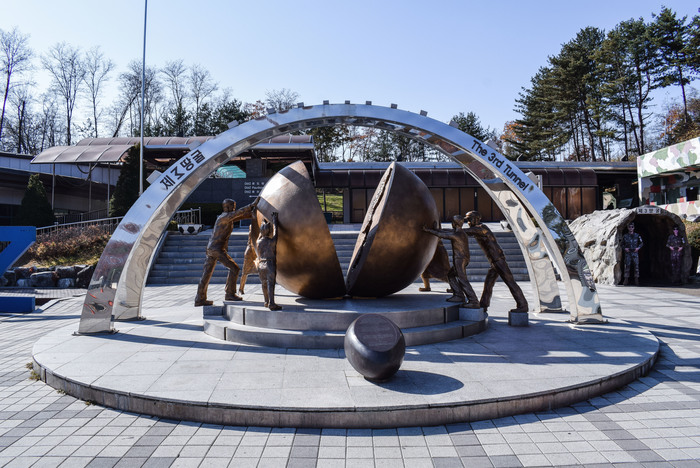
Visit in JSA excluding other parts of the DMZ
A visit to JSA (Panmunjeom) only is a good alternative for those who do not have a time to for a full day tour or want to enjoy a less packed itinerary with more time spent on each location. Such tours usually include a briefing in Camp Bonifas, the Freedom House, Conference Room, Bridge of No Return and the venue of the Axe Murder Incident. This option is also cheaper than the joint tour.
Joint visit in DMZ and JSA
The most expensive but also the most value-packed of the three options. You get to see the JSA + the best of DMZ and it was also my choice when selecting the tour.
The disadvantage of this option is that the schedule can be very packed and you get to spend only a limited time at each location. But its just a small price for being able to see really the best of what the DMZ offers.
How to chose the best tour for you
When selecting which tour to pick for your visit to DMZ and JSA from Seoul, it really depends on both your preferences and time possibilities. The best thing to do is look closer at each of the popular sights in the DMZ and JSA and chose the tour which offers the ones you find the most interesting.
The available tours will most likely consist of these particular locations:
Imjingak park
The Imjingak park or resort was established in 1972 immediately after the declaration of the Armistice Agreement. It lies just next to the DMZ and it includes various attractions and relics connected to the Korean conflict. The most interesting ones are for sure the Freedom Bridge, which is a railroad bridge formerly used for repatriating soldiers returning from the North. Just next to the bridge, you can find an actual locomotive used during the war. The locomotive was partially blown up and completely covered by bullet holes. Such view provides you the best and the saddest testimony about the horrors of the war. One of the attractions to be found in Imjingak is actually a small amusement park. I must say this is probably the creepiest place for such facility I have ever seen in my life.
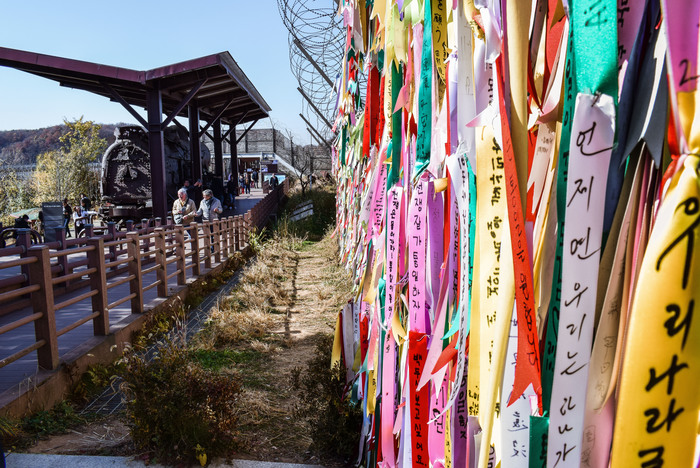
The Third Infiltration Tunnel
The North Koreans never really accepted the Armistice Agreement and they kept on planning a secret invasion to the South. They dug several invasion tunnels, which were supposed to serve as an access for a quick strike on Seoul. The Third Infiltration Tunnel, discovered in 1978, lies only about 44 km from Seoul. It is 1,635 meters long, with a height and width of about 2 meters. It was capable of moving approximately 30,000 soldiers per hour. Nowadays, it is surrounded by the DMZ video hall, memorial sculptures, gift shops and other tourist attractions. Interesting to see, but not my favorite part of the tour.
Dorasan station
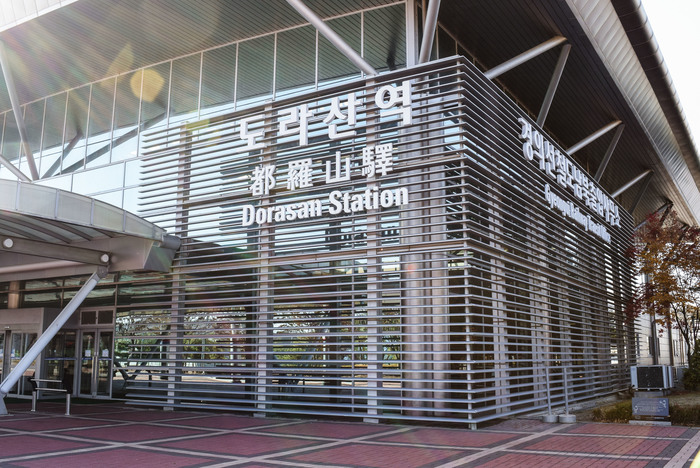
Dorasan station is the northernmost station of Korean railways, lying on the Gyeongui line and located just next to the DMZ. The original station was destroyed during the war, but it has been recently rebuilt from the money of various donors. You can actually buy “a ticket from Dorasan to Pyeongyang” and go to take a look at the platform of the station. There are real trains coming 4 times per day from Seoul, but of course, they do not continue to North Korea. They only serve to bring the employees of the station on the work placement and back. The main message of the station is to be ready for the unification, so the train connection to North Korea can be restored as fast as possible.
Dora Observatory

For me, probably the most interesting part of the tour besides the actual JSA. Basically, you can use binoculars and literally take a look to North Korea. The observatory is located on the Dora mountain, close to the South Korean Daeseong-dong village (located in the actual DMZ) and the North Korean Kijŏng-dong propaganda village, known from the so-called “Flagpole war”. That also means you can see both the famous flagpoles in the binoculars. Unfortunately, as the Kijŏng-dong village serves only for propaganda aims, it is not populated by regular North Koreans, but just by a maintenance stuff. Still, it is really fascinating to observe them by yourself.
Camp Bonifans
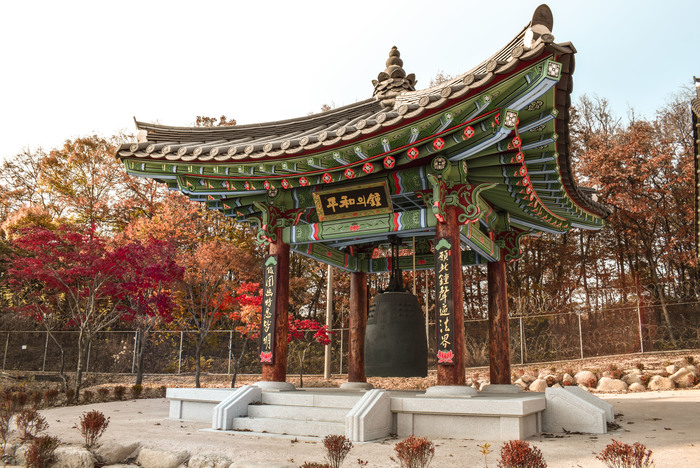
Camp Bonifans is a military post formerly under the UN command located 2,400 meters south of the Military Demarcation Line. It is named after Captain Arthur G. Bonifans murdered during the so-called “Axe Murder Incident”. You will get here your briefing on the history of the Korean conflict and the DMZ from an American soldier just before going further to the JSA. You can see the set up in which the soldiers guarding the JSA live and buy some souvenirs, including Noth Korean products.
Bridge of No Return
Bridge of No Return is the bridge where North Korea and South Korea used to exchange their war prisoners. It got its name from the fact that once they have voluntarily chosen to be returned to North Korea, they were not able to come back to the South. Unfortunately, since the aggravation of the diplomatic relations of the two countries in autumn 2016, landmines have been placed around the bridge by the North and it is thus no longer accessible for a visit.
MAC building
The Military Armistice Commission building is the actual conference room, where the peace talks between the two Koreas used to take place. However, it is no longer used for this purposes. As the building is equally built on the territory of both countries, while being inside the building, you can thus step on the North Korean soil and take photos while doing it.
Axe Murder Incident
The venue of the infamous “Axe Murder Incident” from August 18th, 1976. Two US soldiers, Captain Arthur G. Bonifans and First Lieutenant Mark Barret, lost their life while being attacked by a group of North Korean soldiers during Operation Paul Bunyan. Its aim was to cut down a poplar tree in the JSA, which was blocking the view of UN observers. The event is known as the bloodiest incident which ever happened in the JSA.
Freedom House
The Freedom house was originally built to host reunions of families from the North and the South. However, it has never been used for this purpose, as the North never allowed its citizens to engage in such activities. Now it serves as the main building facing the North side of the JSA.
Which rules and limitations you need to follow
Rules to follow when visiting the DMZ
If you decide to take a tour which does not include a visit to JSA, the rules are usually very simple:
- Always carry your passport with you.
- Dress simply.
- Consumption of alcohol during the tour is prohibited.
Rules to follow when visiting the DMZ
However, if your tour includes a visit to JSA, much severe rules come to place:
- According to the UN rules, the list of the tourists coming to the JSA should be reported 48 hours prior to the tour. Tourists thus need to send their names, passport numbers and nationality to their tour operator at least 3 days before the tour.
- Korean citizens living in Korea are not allowed to enter the JSA.
- Koreans who are overseas residents can join the tour, however, they need to scan and send their overseas resident registration issued by Korean Embassy in an e-mail along with their passport number and name at least 4 days prior to the tour day.
- The following countries are required to have a Background Check from the UN for the tour and they are thus requested to provide the scan of their passports at least 4 days prior to the tour day to their tour operator: Afghanistan, Algeria, Azerbaijan, Bahrain, Bangladesh, Belarus, Bolivia, Bosnia, Burma, China, Cuba, Egypt, Estonia, Georgia, Hong Kong, India, Indonesia, Iran, Iraq, Israel, Jordan, Kazakhstan, Kuwait, Kyrgyzstan, Latvia, Lebanon, Libya, Lithuania, Macau, Malaysia, Moldova, Morocco, Nigeria, North Korea, Oman, Pakistan, Palestinian authority, Qatar, Russia, Saudi Arabia, Singapore, Somalia, Sudan, Syria, Taiwan, Tajikistan, Tunisia, Turkmenistan, Ukraine, United Arab Emirates, Uzbekistan, Venezuela, Vietnam, Yemen
- Visitors must bring their passport on tour day.
- Strict clothing regulations apply. You cannot join the tour wearing: shorts, faded jeans (without fading accepted), leather clothes, exercise. clothes, sleeveless shirts, miniskirts, knee trousers, sandals, and slippers (if there is a strap on the heel, they are accepted), round neck t-shirt, dresses, military uniform style clothes, hats.
- These items are prohibited on the tour: wheelchairs, walking sticks and umbrellas (raincoats are fine).
- Cameras with zooming lens over 90mms are not allowed neither.
What else do I need to know
- If you are planning to visit also the JSA, be sure to book your tour at least one month in advance. Otherwise, you may find all the places in your term booked out. In such case, you can still take at least the DMZ tour without visiting the JSA.
- Children under 11 years old are not allowed on the JSA tours.
- You need to be aware that there is always a risk that your tour might be suddenly canceled for various reasons. We took ours on 9th November 2017 and we were very lucky. The tours on 8th were canceled because of the visit of the US President Donald Trump in the JSA, which was in the end canceled as well. Defections or repatriations may be another reason for sudden cancelations of the tours. In such case, you may get only a partial refund or even no refund at all.
Let me hear from you
If you have read down here, you are probably interested in visiting the DMZ, which is excellent. There is an unforgettable experience waiting for you. I hope my complete guide on how to see the DMZ and JSA from Seoul provided you with all the necessary information for your trip. If you have any further questions, please do not hesitate to ask me in the comments below. I will also look forward to hearing about your experience visiting the DMZ.
Love, Katie

